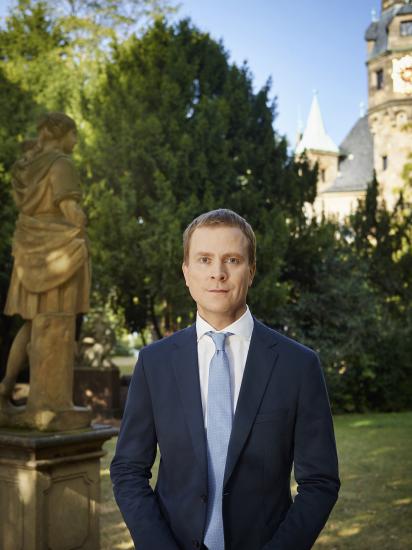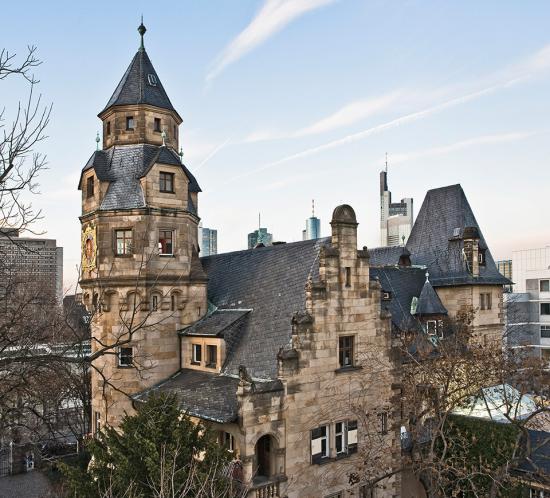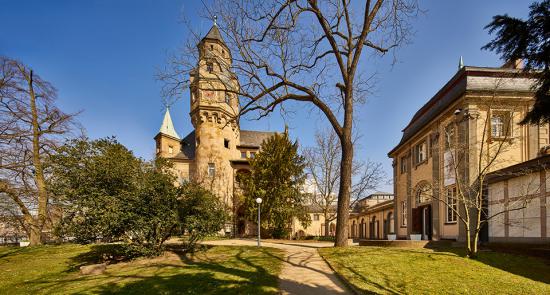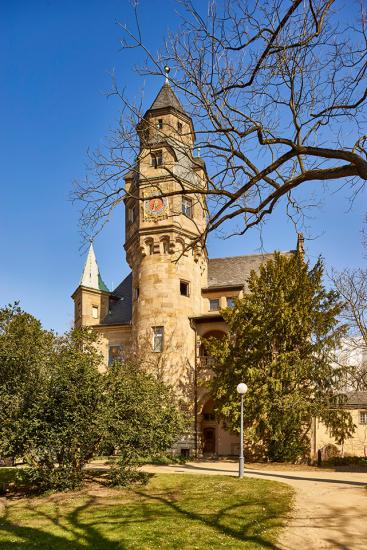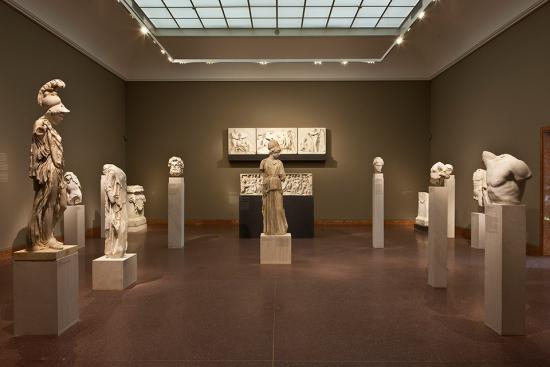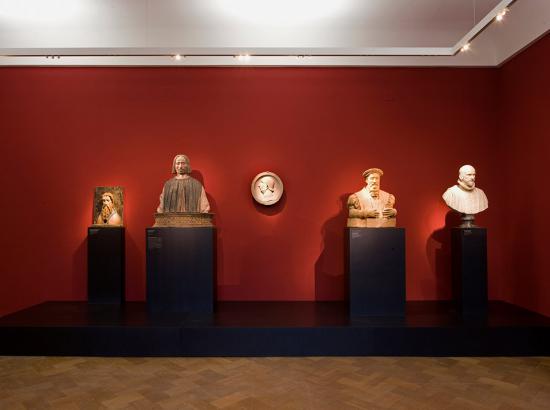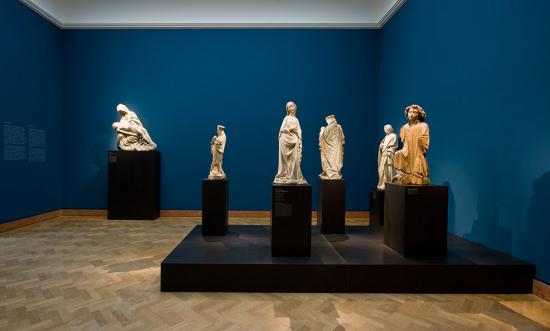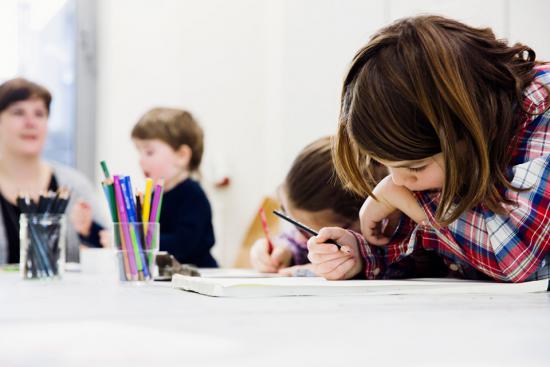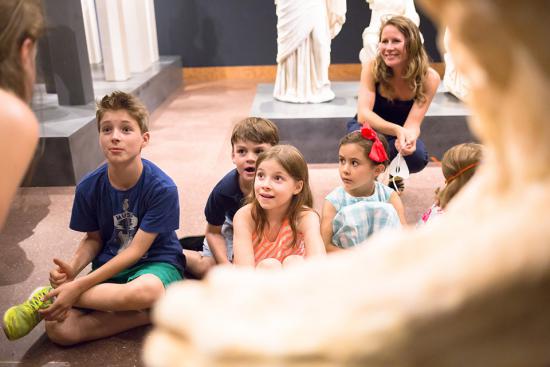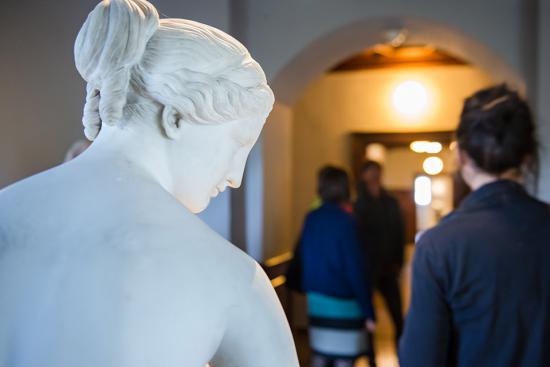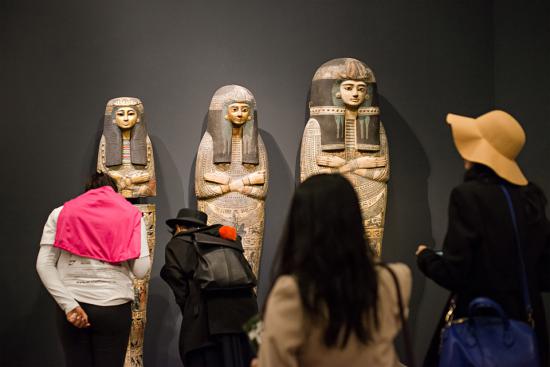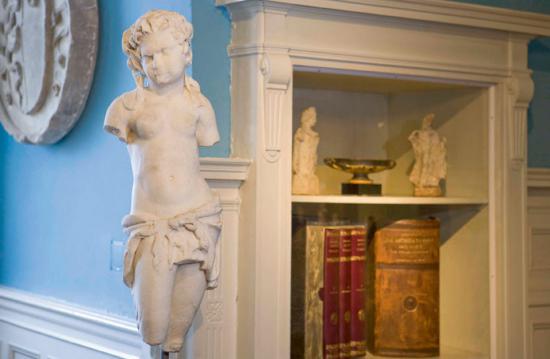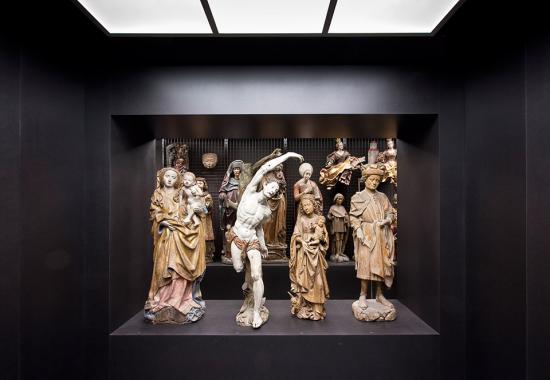Information on the collection, its history, and its educational program
With more than 3,000 works presented on an exhibition area of 1,600 square meters, the Liebieghaus, centrally located on the Museum Embankment in Frankfurt am Main, ranks among the internationally most important sculpture museums. The collection encompasses outstanding works whose range spans from Ancient Egypt to Neoclassicism: with exhibits from Egyptian, Greek and Roman Antiquity, the Middle Ages and the Renaissance, Mannerism, the Baroque, and Rococo, Neoclassicism and the Far East, its manifold holdings offer a substantial survey of 5,000 years of sculpture. The collection’s numerous masterpieces include the marble sculpture of Athena (c. 450 BC) after Myron, Tilman Riemenschneider’s sandstone Virgin Mary (c. 1520), and the terracotta altar by Andrea della Robbia (c. 1500). In recent years, the Liebieghaus attracted a lot of public interest with its comprehensive exhibition and research projects such as “Machine Room of the Gods. How Our Future Was Invented” (2023/2024), “Gods in Color. Painted Sculpture of Classical Antiquity” (2008/2009), “Jean-Antoine Houdon: Sculpture and Sensibility” (2009/2010), or “Niclaus Gerhaert. The Medieval Sculptor” (2012) and convinced the experts with its publications and scholarly activities.
Presentation of the collection and educational program
Right on time with the centenary of the institution, the permanent exhibition of the Liebieghaus Sculpture Collection was presented in a completely new form in 2009. This comprehensive infrastructural change went hand in hand with the realization of a novel overall color concept and the installation of an innovative lighting system. The villa’s splendid attic story has also been made accessible to the public. Furnished with costly wainscoting, its rooms present themselves as atmospheric studioli and invite the visitor to discover the wealth of the German Gründerzeit. The also newly furnished depot of the Liebieghaus with its groups of objects offers unusual opportunities for comparison: the presentation in the Open Depot assembles works of a large variety of formats and materials from all departments that have been displayed only rarely to date or have not been on exhibit at all for a long time.
The exhibitions and permanent presentations of the Liebieghaus Sculpture Collection are accompanied by a manifold program of events and educational programs for children and young people as well as for grown-ups, families and senior citizens. With its numerous projects such as KinderKunstKlub or the Summer Academy, the Liebieghaus successfully addresses a wide range of visitor groups and, relying on target-group-tailored offers like “Art after work,” “Kunstkolleg,” or “Art and Religion,” provides a comprehensive and fascinating spectrum of extended contents concerning its exhibitions and collection areas. Children and young people are made familiar with the basic techniques of sculpture in vacation courses, studio workshops, and special classes. Experts in the field regularly lecture on relevant aspects of the subjects highlighted in the special exhibitions or by masterpieces of the collection, offering well-founded background information and multifarious insights.
The history of the Liebieghaus
The Bohemian textile manufacturer Heinrich Baron von Liebieg (1839–1904) bequeathed his villa on the Schaumainkai – built after plans by the Munich architect Leonhard Romeis in the 1890s – to the City of Frankfurt at a preferential price under the condition that it would accommodate “a public art museum for all time.” Extended through the addition of a gallery wing, the villa opened its doors to the public as a municipal sculpture museum only two years after its foundation in 1909, providing a counterpart to the Städel’s already existing collection of paintings. The founding director Georg Swarzenski’s paramount goal was “to illustrate the development of sculpture among the civilized nations during historical ages by collecting outstanding or characteristic works.” The collection built up should be exclusively dedicated to sculpture. Numerous outstanding works could already be acquired for the museum within just a few years in the early twentieth century.
It was Herbert Beck who controlled the fortunes of the Liebieghaus from 1969 to 2006; in 1994, he was also appointed Director of the Städel Museum. The traditional tasks of a museum – education, collecting, preservation, and research – received new impulses during this period. These years were characterized by important scholarly research projects – which sometimes resulted in widely acclaimed exhibitions – and major acquisitions. In 2006, Max Hollein succeeded Beck as Director of the Liebieghaus Sculpture Collection and the Städel Museum. Collaborating with Kuehn Malvezzi Architects of Berlin and the various departments’ heads, the Liebieghaus already started working on the new presentation of its collections of the Middle Ages and the Renaissance to Rococo periods toward the end of 2007. Since the conclusion of the measures in 2009, the Liebieghaus Sculptural Collection has been able to steadily increase the number of its visitors, notching up its hitherto best result with 153,737 visitors in 2012, the one hundred and fourth year of its existence. In October 2016, Philipp Demandt took office as director of the Liebieghaus, the Städel Museum and Schirn Kunsthalle Frankfurt.
In contrast to other museums that originated from princely collections, the Sculpture Collection in the Liebieghaus is a remarkable result of the city’s and its citizens’ commitment. The attachment of Frankfurt’s citizenry, which becomes particularly manifest in its donations to the Liebieghaus, is a fundamental aspect of the museum’s self-understanding and is still cultivated in a special way.
Venue: Liebieghaus Skulpturensammlung, Schaumainkai 71, 60596 Frankfurt am Main
Opening hours: Tue, Wed 12:00 a.m. – 6:00 p.m, Thu 10:00 a.m. – 9:00 p.m, Fri–Sun 10:00 a.m. – 6:00 p.m., closed on Mondays.
Information: liebieghaus.de, info@liebieghaus.de, phone: +49(0)69-650049-0,
fax:+49(0)69-650049-150
Director: Dr. Philipp Demandt
Curators: Prof. Dr. Vinzenz Brinkmann (Head of Antiquity), Dr. Stefan Roller (Head of Middle Ages)
Press office: Pamela Rohde, Susanne Hafner, Elisabeth Pallentin, Carolin Fuhr
Städel Museum, Dürerstraße 2, 60596 Frankfurt, phone: +49(0)69-605098-170,
fax: +49(0)69-605098-188, presse@liebieghaus.de, press downloads under liebieghaus.de
 01.12.2025: Tiere sind auch nur Menschen. Skulpturen von August Gaul
01.12.2025: Tiere sind auch nur Menschen. Skulpturen von August Gaul
 19.03.2025: Isa Genzken meets Liebieghaus
19.03.2025: Isa Genzken meets Liebieghaus
 23.03.2023: Maschinenraum der Götter. Wie unsere Zukunft erfunden wurde
23.03.2023: Maschinenraum der Götter. Wie unsere Zukunft erfunden wurde
 01.09.2020: Rundgang BUNTE GÖTTER – GOLDEN EDITION. Die Farben der Antike
01.09.2020: Rundgang BUNTE GÖTTER – GOLDEN EDITION. Die Farben der Antike
 14.02.2020: Antike Skulptur war bunt! BUNTE GÖTTER – GOLDEN EDITION. Die Farben der Antike. Film zur Ausstellung
14.02.2020: Antike Skulptur war bunt! BUNTE GÖTTER – GOLDEN EDITION. Die Farben der Antike. Film zur Ausstellung
 12.09.2019: Der Rimini Altar – Auf dem Weg zu neuem Glanz
12.09.2019: Der Rimini Altar – Auf dem Weg zu neuem Glanz
 07.08.2019: White Wedding. Die Elfenbein-Sammlung Reiner Winkler im Liebieghaus.
07.08.2019: White Wedding. Die Elfenbein-Sammlung Reiner Winkler im Liebieghaus.
 10.07.2019: White Wedding. Die Elfenbein-Sammlung Reiner Winkler jetzt im Liebieghaus. – Trailer
10.07.2019: White Wedding. Die Elfenbein-Sammlung Reiner Winkler jetzt im Liebieghaus. – Trailer
 06.04.2018: William Kentridge. O Sentimental Machine
06.04.2018: William Kentridge. O Sentimental Machine
 05.04.2018: Ein Vortrag von William Kentridge über seine Performance "The Head and the Load"
05.04.2018: Ein Vortrag von William Kentridge über seine Performance "The Head and the Load"
